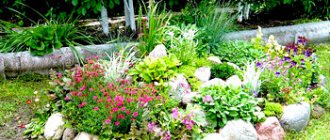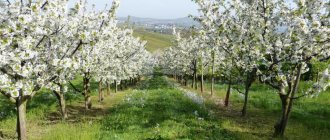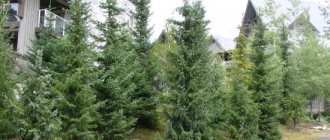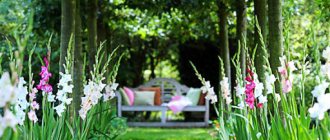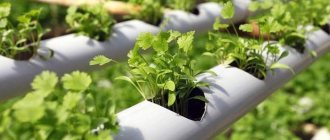For many land owners, one of the priorities is to fully utilize the entire large land area available in their possession. But there are those who have a completely opposite task - how to plant a vegetable garden on a small plot, where to find space for all the necessary crops?
This task is completely solvable, since with proper arrangement of the site there will be enough space for everything, the main thing is to know the secrets of planning, placement and crop rotation of grown plants, in which even a small vegetable garden in a small area near the house will produce an excellent harvest.
The possibility of effectively growing a sufficient amount of vegetables and fruits in a small area was proven experimentally back in the USSR in the 60s of the last century. In some regions of the country, residents were offered small plots of land, only 4 acres, with two conditions:
1. They had to cultivate the land only manually, without the use of mechanized equipment.
2. It was necessary to do treatment and care no more than 2 times a week.
The experiment yielded impressive results - the harvest from a small plot with relatively infrequent processing provided the average family of four with vegetables for the entire next year.
So for those for whom the pressing question is what to plant on 4 acres of land, the information in this article will be useful.
Secret #10: Start the season early and end later.
By adding a few weeks at the beginning and end of the season, there is time for additional harvest. You can grow a late tomato or lettuce at the end of the season. To take advantage of these weeks you need to prepare. Shelters or greenhouses can be used to heat the air or soil. In this way, growth can be maintained even in cold weather.
“In the spring, I use portable, individual plastic covers for in-ground cucumbers and squash to promote early growth,” said Paul Doscher. “In New Hampshire, this additional insulation allows seedlings to be planted in the ground as early as early May, which is very important.” In addition, he uses a cool greenhouse to harden off seedlings and grow seedlings in December.
You can pre-warm the soil in the beds using black mulch film with holes for plants. It is better to do this one and a half to two months before the end of the winter frosts. An arched greenhouse made of transparent perforated film is placed above the beds, which is attached to the frame. This design allows the soil to warm up well, and when the soil temperature reaches 18 degrees, straw 2-3 cm thick is laid on top of the film, which protects the soil from overheating. With the onset of warm weather, you can remove the greenhouse and put it back only in the fall with the onset of cold weather.
Another design consists of a metal mesh bent into an acrylic shape, with a transparent film stretched over the frame. You can even secure the film with clothespins. “As the weather gets warmer, I open the gaps between the sheets to let the hot air out, and later I remove the film completely, but leave the mesh in place as it protects the crops from birds and wildlife,” explains Mel Bartholomew.
Growing in high beds without the use of insulation allows you to extend the season even in places where the soil takes a long time to warm up. This form warms up faster, drains better and allows you to start planting earlier.
Secret #3: Process a little at a time. One square meter at a time
Small plots have their advantages, says Mel Bartholomew, author of the best-selling book This Extraordinary Square. Mel calculated that if he had grown vegetables in rows rather than in beds with wooden frames, he would have needed five times as much space to produce the same yield.
In his opinion, in this way you can save up to 80% of water during irrigation, up to 80% of fertilizers and up to 80% of labor.
In order to make the small garden convenient for processing and care, Mel divided each bed measuring 1.2 by 1.2 m into 16 squares (0.30 x 0.30 m). On each square you can plant different crops as you wish. For example, grow one tomato bush or 4 heads of lettuce, or 9 bean bushes or 16 radish bushes.
Dwarf spruce
Slow-growing dwarf spruce trees - yes, there are such ones - are an excellent option for a mini-garden. Instead of a branching tree 4-5 m high, today you can buy a seedling, which even in adulthood will not grow higher than 1-2.5 m, giving only about 10 cm of growth per year. Tell me, is it tempting to admire a neat Christmas tree growing under the window, which in winter can be decorated for the holidays?
You can choose a standard, cushion-shaped or familiar type of spruce - it all depends on the chosen variety and your design ideas. Thus, the cushion-shaped varieties Zagwizdze and Nidiformis are perfect for decorating rocky gardens and forming low borders. The dwarf spruce Little Gem has a dense spherical crown, while the Will's Zwerg variety has a dense, narrow-conical crown. There are even creeping forms of dwarf spruce trees, for example, the Nana variety.
Spruce trees need to be planted in sunny or semi-shaded places. Remember that they are demanding of air and soil moisture and do not tolerate salinity - choose moist, fertile, well-drained soils, do not forget about artificial irrigation and abundant watering in the dry season. At first, you need to protect the young plant from spring frosts and sunburn. Also, dwarf spruce will gratefully respond to feeding. If you decide that the crown is already well formed, add annual pinching of young shoots to the care of the tree.
Continuity of cultivation: different sowing and ripening times
Ensure the productivity of your mini-garden throughout the growing season. Plant a series of crops in a row in a bed or container, starting in the cool season. There are plants that ripen early in the spring, and then in the middle of the season and in late summer.
The idea behind continuous growing is to avoid letting garden space go empty. For example, harvest early lettuce or fast-maturing corn and then plant later crops there.
The same method is used to extend the growing season of fast-maturing crops such as radishes and beans. Plant them at intervals of two to three weeks and reap several harvests.
Multi-tiered bed.
It is easy to make from wooden boxes stacked on top of each other. Suitable for growing vegetables - carrots or beets - as well as herbs, herbs and strawberries.
There is only one difficulty - organizing high-quality drainage in containers and watering more often than usual, but containers placed on the stairs and porch, near the gazebo and along the paths will additionally decorate the area.
Landing rules
Rules that will help those who are wondering how and what to plant in a small area.
Fertilize and improve the soil on the site
Loose soil rich in essential elements is the key to productivity. It is necessary to introduce the necessary elements to the depth of the plant root system - this is about 40-50 centimeters.
Proper rotation of varieties
By sowing crops of different ripening periods, you can save the necessary space. Instead of several beds of late varieties of carrots, you can plant one bed of late varieties, and plant early carrots on the second, which can be used in July, freeing up space for planting, for example, daikon.
Or plant seedlings of tomatoes and peppers no earlier than in June, sowing peas before them in early spring, which will have time to ripen by this time.
Sealing fit
A wonderful option for placing “neighboring” vegetables.
Radishes, dill, and lettuce are planted between rows of plants that take up little space at the beginning of the growing season - potatoes, cucumbers, zucchini.
Tomatoes will coexist well with currant bushes, which, in turn, will be happy with such a neighborhood - the tomato phytoncides will repel currant pests.
You can plant spinach between the rows of carrots, beets, peppers, garlic and cabbage, onions and garlic along the rows of strawberries, and diversify the potato rows with rows of garlic or cabbage.
Tall corn will serve as a support for beans, zucchini and pumpkin; in return, the beans will help in the accumulation of nitrogen in the soil.
You can figure out the correct neighborhood using the compatibility table.
More attention to varieties
When purchasing seeds, give preference to compact and/or low-growing varieties of the same crops, which allow you to save on space but still have the same amount of yield.
This article is about choosing the most suitable apple trees for a small area.
Correct layout
On long winter evenings, in anticipation of the spring-summer dacha season, it is worthwhile to start planning future beds, on which to clearly and in detail indicate where and what will be planted. Rational planning and correct selection of the necessary crops help to significantly save space.
One of the options for placing vegetable crops in a small area.
Interesting on the topic:
10 remarkably beautiful annual vines that are worth...
Jan 15, 2022
I grow lush bushes of ground cover roses - gorgeous...
Jan 15, 2022
Another option for planning a vegetable garden with an area of 1.5 acres.
Designing beds in the form of a French vegetable garden, where the frame is a hedge, looks beautiful and saves space.
We observe crop rotation
We remember that each culture takes from the earth certain substances and minerals it needs. This is how cabbage “pulls” magnesium out of the soil, but leaves potassium and sodium, which it is indifferent to.
Therefore, it would be logical the next time you plant, swap cabbage with the same beets, which do not need magnesium, but love soil rich in potassium and sodium.
For novice gardeners, there is a simple rule: you cannot grow the same crop in one place for 2 or more years in a row, so you simply need to move the beds every year, for example, clockwise, and the vegetable crops will return to their place place after a period of time sufficient to restore the soil.
Vertical plantings
This arrangement of beds is not only a tribute to fashion, but is popular because vertical planting of vegetables saves space, making it possible to get a good harvest.
In addition, this method protects plants from fungal diseases: thanks to constant air circulation, the fungus simply does not have time to develop.
For climbing plants, simple structures are built that are installed in convenient places where they will not take up the right place. Beans or peas can be sown near fruit trees by sticking poles about 2 meters high next to them. Having first braided the poles, the beans will reach the branches of the trees, along which they will continue to curl.
The most suitable vegetables for growing using vertical planting are tomatoes and cucumbers, the most suitable berries are strawberries.
Lattice or nets will not only help cucumbers or tomatoes rise up, but will also serve as decoration for the area.
How to decorate a terrace or porch with hanging tomatoes in pots.
Terraces and spiral-shaped snail beds are suitable for growing strawberries and wild strawberries.
Strawberries can also be grown in columns, which are filled with soil, and strawberry bushes are planted in pre-prepared holes.
Non-standard beds
Barrel bed. A barrel that has become unsuitable for storing water can be adapted for growing cucumbers by filling the barrel in layers with branches, bark, hay, compost and soil.? Cucumbers grow well in such barrels, saving space in the garden.
For planting, you can also use old buckets, pots and other containers that have become unnecessary.
Bag bed. It can be made from a polypropylene bag. But you need to take into account that such a “bed” needs good drainage and frequent watering.
Features of the garden layout
In landscape design, the components of the garden and vegetable garden form a harmonious picture. Chaotic placement of different plants will negatively affect the overall composition. Crops are planted in a rectangular or checkerboard pattern. The color and size of the fruit and the shape of the foliage refreshes the space. The combination of green, yellow and red pleasantly enlivens the area.
Garden in the yard Source nightmare.ru.net
For gardening and berry plantings in the garden, choose the sunniest place that is easy to water. On a compact plot, crops are planted in vertical beds. Strawberries grow well in containers, and raspberries grow well in barrels. Mobile options move to any corner.
Trees are the largest element of the garden, which negatively affects the existence of neighboring plants. To prevent developing roots from harming buildings, it is necessary to maintain a distance of 3 m from buildings. In landscape design, crops are used to create recreation areas. Alleys of fruit species, pergolas, arches with grapes look beautiful.
Beautiful path to the garden Source www.liveinternet.ru
Flowerbeds are a bright element of a site that can be planted with flowers, vegetables and berries. A vertical strawberry bed is installed in the center of the structure. On the sides there are rows for decorative cabbage, lettuce and carrots. Marigolds, calendula and mint are planted along the perimeter border.
Increasing the height of the beds helps increase the yield
A quick and effective way to increase the depth of the fertile soil layer is high beds. This can be achieved by digging the beds twice to double depth. In this way, you can make a large, lush ridge with a loose layer of earth, which will reach a depth of 60 cm and rise above its surface by 5-25 cm.
Of course, double digging requires a lot of effort, but the result will be worth it: the harvest that you can get will be 4 times higher than your usual, and the need for processing next time will be at a minimum. You will need 30 minutes to loosen the ridges, which have an area of 10 square meters. m, had already been dug up earlier.
Dan Woolley, a researcher at the University of Missouri, suggests that in a vegetable garden, which is planned in the form of beds with an area of 42 square meters. m, it is possible to grow half a ton of vegetables, and with row planting, you can cultivate only half the amount that was indicated.
Saving time should also be pursued along with saving space and labor. Raised beds can still save time. Plants are planted very close and the shadow they cast suppresses the appearance of weeds and therefore weeding takes much less time. In addition, when seedlings are closely spaced in high beds, time spent on harvesting and watering is reduced.
climbing rose
Climbing roses can become a bright accent in your small garden and simply transform the space by decorating arches, gazebos, hedges and other vertical surfaces. The bushes are perfectly suited to a monochrome background such as a dark thicket of conifers or a brick wall, although other plants such as silver wormwood, heuchera, lavender, gypsophila, sage or the same climbing grapes can become good neighbors.
Moreover, contrary to the widespread belief that any roses are “whimsical”, in fact, it is enough to follow the basic rules of caring for the plant so that it feels good and delights with lush flowering.
Advising the best varieties of climbing roses is a thankless task; there are hundreds of options for every taste and color, everyone will choose the right rambler or climber for their site. It’s better to talk a little about the process of caring for the queen of flowers.
It is better to plant a climbing rose in the fall in a well-lit area with loose, fertile soil. During the growing season, do not forget about regular but moderate watering and loosening the soil; starting from the second year, add specialized or complex fertilizers. To get a beautiful crown with many flowers, be sure to prune. For the winter, remove the lashes from the supports, carefully bend them to the ground and cover them with spruce branches.
- Everything you need to know about climbing roses
Detailed instructions for caring for climbing roses: planting, feeding, pruning, shaping.
Secret #6: Don't plant too thickly.
Avoid overly dense planting of plants in the beds. In this case, some crops are simply unable to grow fully. In this case, a decrease in yield will be a completely natural result.
The distance between bushes for each type of plant must be selected individually. As a rule, the optimal distance is indicated on the package with seeds; in other cases, you can seek help from reference books or articles on each individual crop.
It is important to understand that the volume of yield per square meter is more important than the number of plants on the same square meter. By increasing planting density more than necessary, you make plants more susceptible to pests and diseases.
Site location
Plots of land with a completely flat surface are a rare occurrence. Much more often, many of them have their own disadvantages, which must be taken into account when setting up a vegetable garden. So, if they are in a low-lying area, this can lead to increased soil moisture. In this case, you will need to build drainage outlets, as well as add soil to the beds from time to time.
If the site is located on a slope, the beds should be made not along it, but across it.
Areas in elevated areas are exposed to winds, so to create a barrier to drafts, they need to be planted with tall plantings (trees, shrubs) around the perimeter.
How to plant a vegetable garden correctly: we begin to prepare in winter
Even if you are a highly experienced summer resident, it is better to take care of planning your garden in the winter months. Long, dark evenings will help you evaluate the experience of past years in a calm atmosphere and read useful recommendations. There are a few points to consider first:
- sequence of arrangement of beds;
- optimal crop rotation system;
- rational fertilizer system;
- effective protection against pests.
You may be interested in: Drip irrigation: pros and cons, types of drip irrigation systems, installation diagrams
Photo gallery:
Vertical plant formation
Growing climbing crops such as tomatoes, cucumbers, beans, peas, zucchini, melons, etc., saves space and time for harvesting. Vertically growing plants are less susceptible to fungal diseases. For successful cultivation, trellises, fences or stakes are used.
Trellis come in a variety of shapes, styles and materials. Ropes and wire can be stretched between two pillars and a mesh can be secured. Using simple poles fixed at the top, you can give them a pyramidal shape.
Pergolas are also used, which are an open lattice supported by 4 pillars. They are used in front of the entrance to the house or mask unsightly corners of the garden.
Hydrangea paniculata
This beautifully flowering plant will perfectly decorate a shady and humid corner of the garden, pleasing the eye with abundant and long-lasting flowering. The openwork pyramid inflorescences of such hydrangeas come in a wide variety of colors - from white and pink to lemon and even bicolors. This crop is ideal for single and group plantings; it looks good next to conifers, hostas, ferns and other shade-tolerant plants.
In a small garden plot, you can plant the following fairly compact varieties of paniculate hydrangea: Bombshell, Little Lime, Bobo, Dharuma, Last Post, Brussels Lace, etc.
- Hydrangea paniculata: the best varieties for the Moscow region (with photos, names and descriptions)
Chic plants for a chic garden - this is about paniculata hydrangea!
For the middle zone, this plant is quite unpretentious and responds well to fertilizing and watering. Some varieties are distinguished by high frost resistance and the ability to quickly recover after the loss of a large part of the shoots.
Hydrangea paniculata is planted in the spring, in an area with fairly acidic soil and mild sun. Hydrangea does not tolerate stagnation of water or drought, so watering must be regular. As well as fertilizing - otherwise you will not achieve lush flowering. Also, for abundant flowering before the growing season, the bushes must be heavily pruned annually.
- 8 most important questions about planting and caring for hydrangeas
Simple step-by-step instructions on how to grow an unpretentious and beautiful hydrangea.
Barberry Thunberg
This deciduous shrub is especially beautiful in autumn due to the bright color of the leaves and the coral-red fruits that hang on the branches for a long time. Thunberg barberry is exclusively decorative and has many different varieties, differing primarily in the size of the bush, the shape of the crown and the color of the glossy leaves.
This plant is resistant to diseases and pests, light-loving, drought-resistant and winter-hardy. It looks good in group and solitary plantings, can act as a hedge or become a backdrop for flower arrangements.
Barberry is also unpretentious in care. It is planted on light, air- and moisture-permeable soils, in a place protected from drafts. Except during prolonged drought, this plant does not need watering. Occasionally, the soil around the bushes can be slightly loosened. Before winter, it is mulched, and once a year in the spring, organic fertilizers are applied. Only bushes with a loose crown in order to form it and shoots that have frozen over the winter need pruning (also done in the spring).
For a small garden, medium-sized varieties of Thunberg barberry are suitable - Aurea, Golden Ring, Admiration, Green Carpet, Atropurpurea Nana, Orange Rocket, etc.
- Barberry Thunberg - photos and descriptions of the most beautiful varieties
If you think that “barberry” is just a candy, come to us!
Maiden (wild) grapes, or Parthenocissus
This fast-growing climbing plant is ideal for masking solid vertical surfaces or for decorating design structures on the site - arches, arbors, etc. The variety of its species with leaves of different shapes and colors allows you to create a variety of compositions with its participation.
Wild grapes are not capricious. In the first year of development, it needs abundant watering, and before planting it is worth adding humus and complex fertilizers to the hole. And all other years, the plant requires almost no care - it grows well both in the sun and in the shade, is unpretentious to the composition of the soil, and can withstand even the harshest winters without shelter. The main care for this vine will consist of forming the type of crown you need and trimming excess lashes.
- The best perennial climbing plants for gazebos and gardens (21 photos)
What vines are best suited for decorating gazebos?
Using Multifunctional Plants
Multifunctional plants are those that perform several functions simultaneously.
Eg:
- Corn not only produces cobs, it can serve as a support for cucumbers;
- Rose hips will perfectly decorate the garden with flowers, act as a hedge, and bear useful fruits;
- Radishes planted in front of tomatoes not only produce fruit, but also serve as green manure.
Using multi-functional plants will allow you to make more efficient use of a small space.
